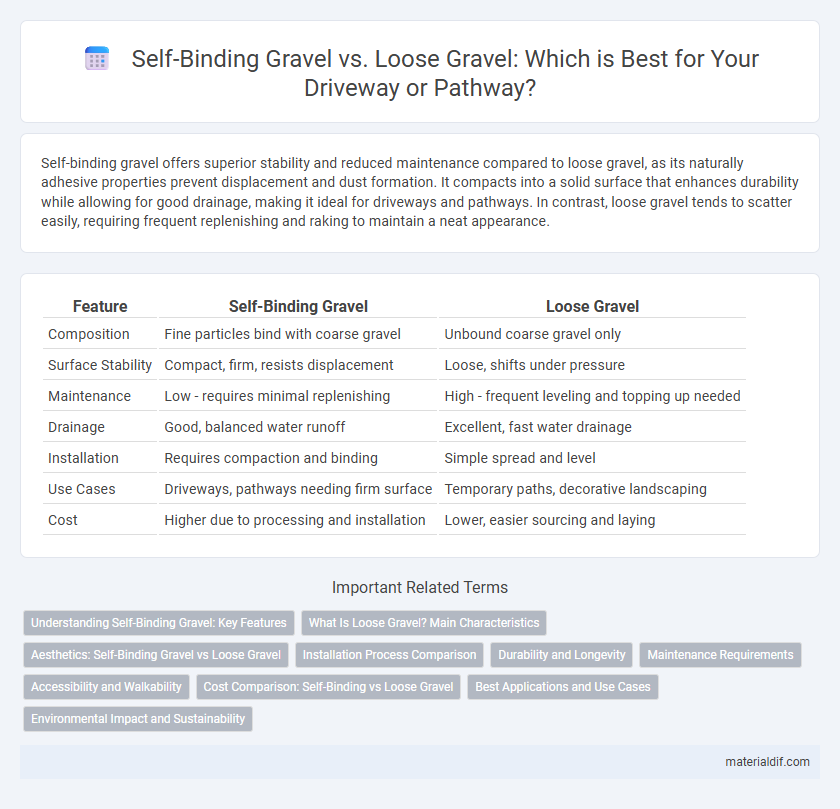Self-binding gravel offers superior stability and reduced maintenance compared to loose gravel, as its naturally adhesive properties prevent displacement and dust formation. It compacts into a solid surface that enhances durability while allowing for good drainage, making it ideal for driveways and pathways. In contrast, loose gravel tends to scatter easily, requiring frequent replenishing and raking to maintain a neat appearance.
Table of Comparison
| Feature | Self-Binding Gravel | Loose Gravel |
|---|---|---|
| Composition | Fine particles bind with coarse gravel | Unbound coarse gravel only |
| Surface Stability | Compact, firm, resists displacement | Loose, shifts under pressure |
| Maintenance | Low - requires minimal replenishing | High - frequent leveling and topping up needed |
| Drainage | Good, balanced water runoff | Excellent, fast water drainage |
| Installation | Requires compaction and binding | Simple spread and level |
| Use Cases | Driveways, pathways needing firm surface | Temporary paths, decorative landscaping |
| Cost | Higher due to processing and installation | Lower, easier sourcing and laying |
Understanding Self-Binding Gravel: Key Features
Self-binding gravel consists of angular crushed stone combined with fine particles that lock together when compacted, creating a stable and durable surface ideal for driveways and pathways. This material offers superior erosion resistance and reduces loose stone displacement compared to traditional loose gravel. Its key features include excellent drainage, low maintenance requirements, and the ability to form a solid, interlocking layer that withstands heavy foot and vehicle traffic.
What Is Loose Gravel? Main Characteristics
Loose gravel consists of small, unbound stones that move independently and lack cohesion, resulting in a surface that can be unstable and prone to shifting under pressure. Its primary characteristics include excellent drainage due to gaps between particles, ease of installation or removal, and a rough texture that provides moderate traction but may require frequent maintenance to prevent displacement. Loose gravel is commonly used in driveways, landscaping, and pathways where flexibility and natural appearance are prioritized over permanence.
Aesthetics: Self-Binding Gravel vs Loose Gravel
Self-binding gravel offers a smoother, more uniform surface that enhances visual appeal by reducing displacement and maintaining defined edges, compared to loose gravel which tends to scatter and create a less tidy appearance. The consolidated surface of self-binding gravel provides a sleek, polished look suitable for pathways and driveways where aesthetics are important. Loose gravel's irregular texture and movement often result in a more rustic, natural appearance but can appear less maintained over time.
Installation Process Comparison
Self-binding gravel requires a more intricate installation process, involving precise compaction and moisture control to activate the natural binding agents that create a stable surface. Loose gravel installation is simpler, often only needing spreading and leveling without compaction, but it may shift over time due to lack of cohesion. The choice impacts long-term maintenance, with self-binding gravel offering greater durability and reduced displacement compared to loose gravel.
Durability and Longevity
Self-binding gravel exhibits superior durability compared to loose gravel due to its natural or added binders that reduce displacement and erosion. This type of gravel maintains its integrity longer under heavy traffic and adverse weather conditions, significantly extending its longevity on driveways and pathways. Loose gravel, lacking cohesion, tends to scatter and degrade faster, requiring frequent replenishment to sustain its surface.
Maintenance Requirements
Self-binding gravel requires less frequent replenishment and reduces dust compared to loose gravel, making it more suitable for high-traffic areas. Its compact surface minimizes weed growth and erosion, significantly lowering routine maintenance efforts. Loose gravel demands regular raking, top-ups, and weed control to maintain an even surface and prevent displacement.
Accessibility and Walkability
Self-binding gravel offers superior accessibility and walkability compared to loose gravel due to its cohesive properties, which create a stable and firm surface ideal for wheelchair users and pedestrians alike. Loose gravel, on the other hand, tends to shift underfoot, causing uneven terrain that can increase the risk of slips, trips, and difficulty in navigating for individuals with mobility challenges. The compacted structure of self-binding gravel reduces displacement, making pathways safer and more comfortable for a diverse range of users.
Cost Comparison: Self-Binding vs Loose Gravel
Self-binding gravel typically costs between $30 to $50 per ton due to its mixture of crushed stone and finer particles that harden upon compaction, while loose gravel ranges from $10 to $30 per ton as plain aggregate without binding agents. Installation expenses for self-binding gravel are higher because it requires precise grading and compaction to achieve a solid surface, whereas loose gravel involves minimal preparation and spreading costs. Maintenance costs for self-binding gravel are lower over time due to reduced displacement and washout compared to loose gravel, which often needs frequent replenishing and grading.
Best Applications and Use Cases
Self-binding gravel, composed of crushed stone with fines that compact firmly, is ideal for high-traffic pathways, driveways, and parking areas requiring durability and stability. Loose gravel, characterized by rounded stones without binding fines, suits decorative landscaping, garden paths, and areas where drainage and flexibility are priorities. Choosing between the two depends on whether structural integrity or aesthetic and permeability is the primary goal.
Environmental Impact and Sustainability
Self-binding gravel offers a more sustainable alternative to loose gravel by reducing erosion and minimizing gravel displacement, which decreases the need for frequent replenishment and lowers the environmental footprint. Its permeability supports natural water drainage, helping to prevent runoff pollution and mitigate soil degradation. Loose gravel, while easier to install, often requires more maintenance and can contribute to sediment runoff, leading to increased environmental disruption.
Self-Binding Gravel vs Loose Gravel Infographic

 materialdif.com
materialdif.com